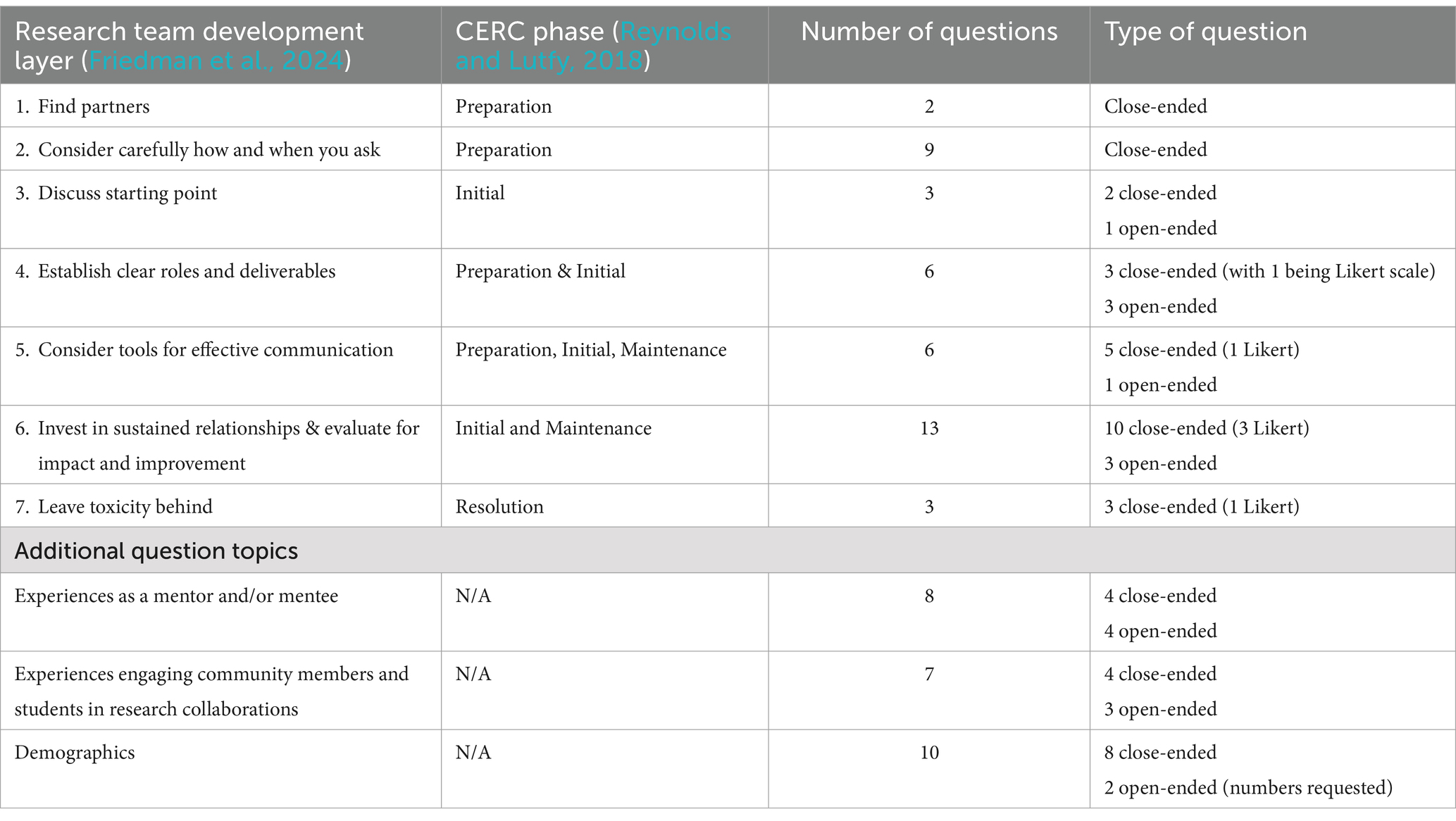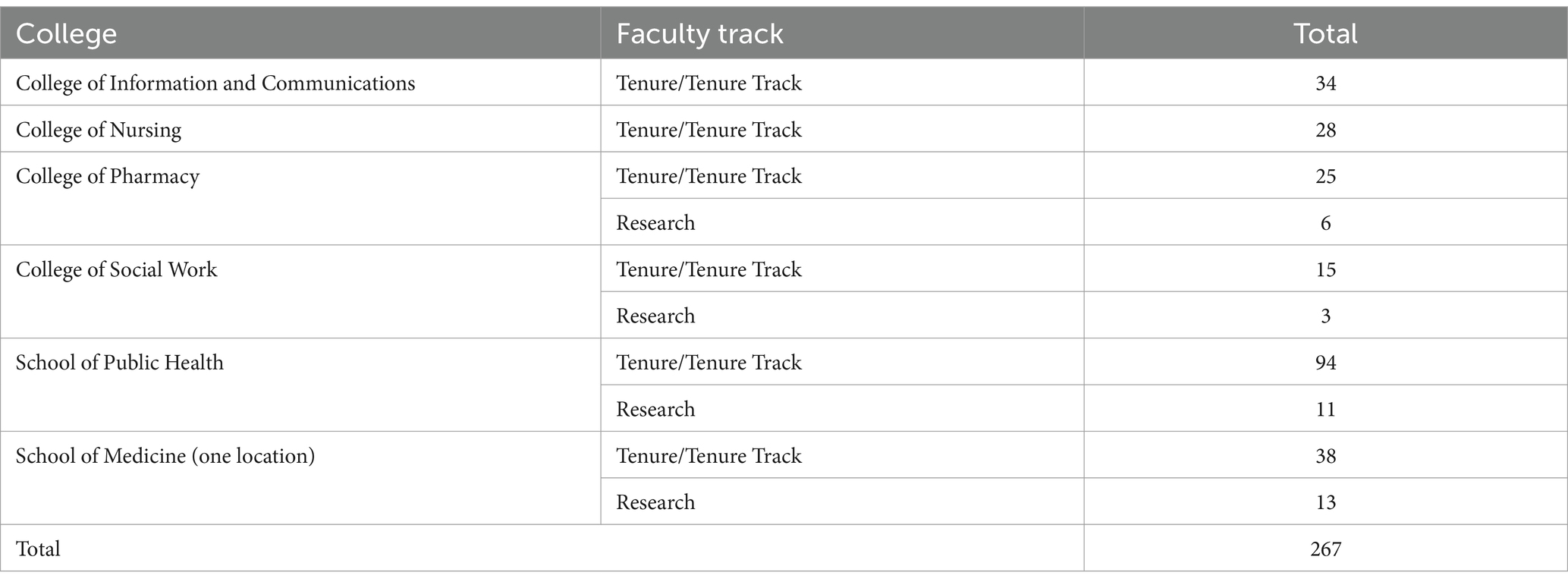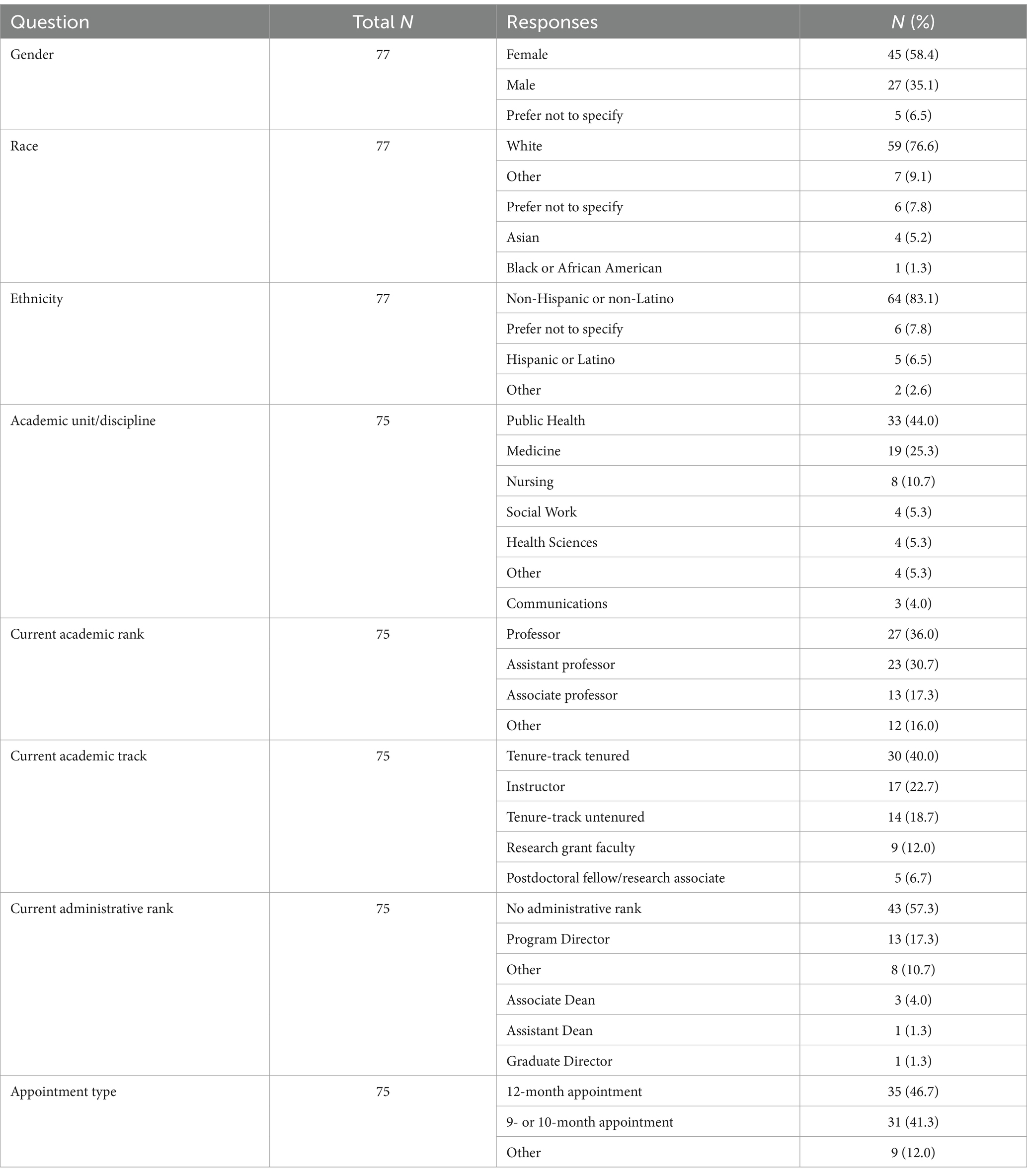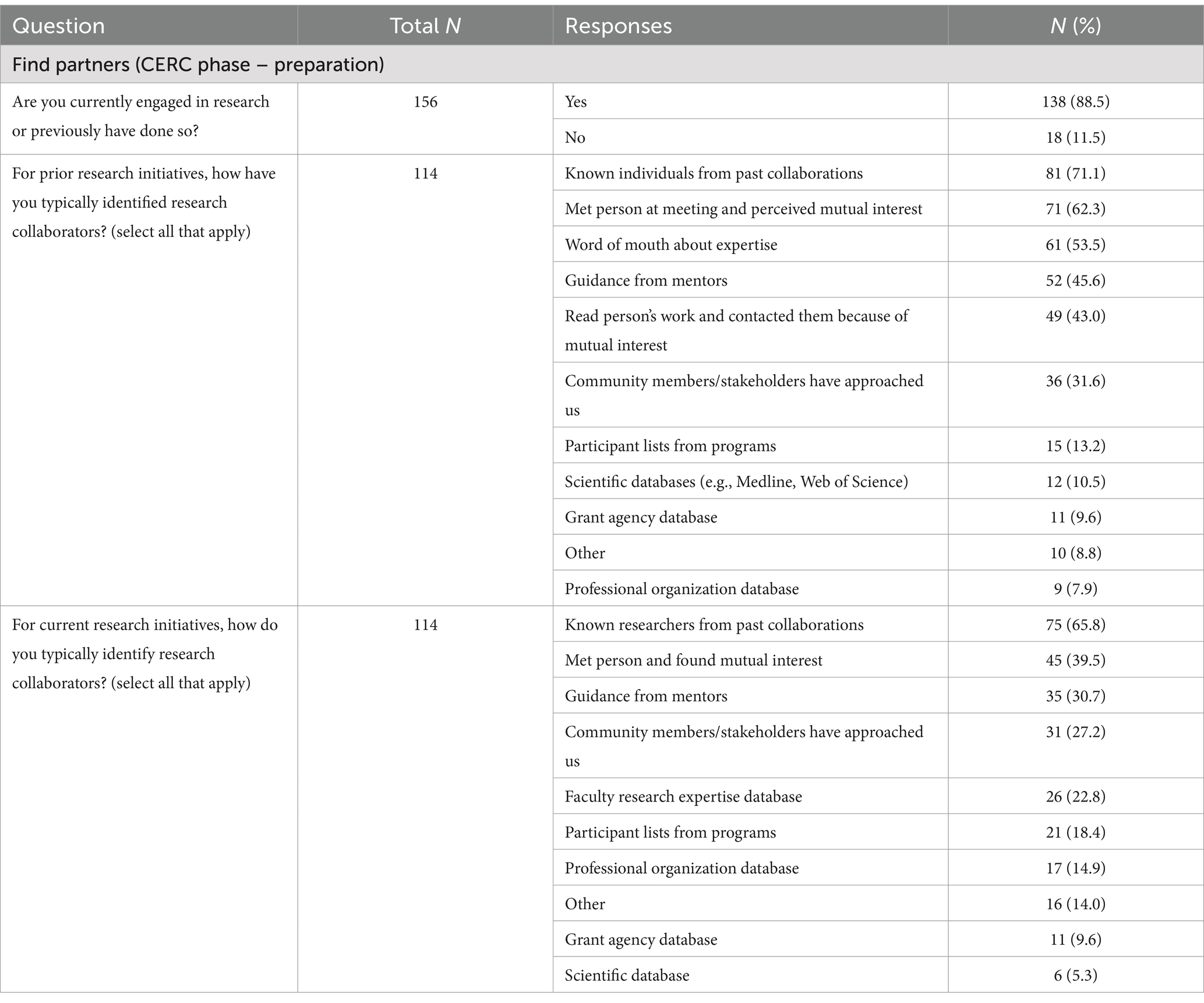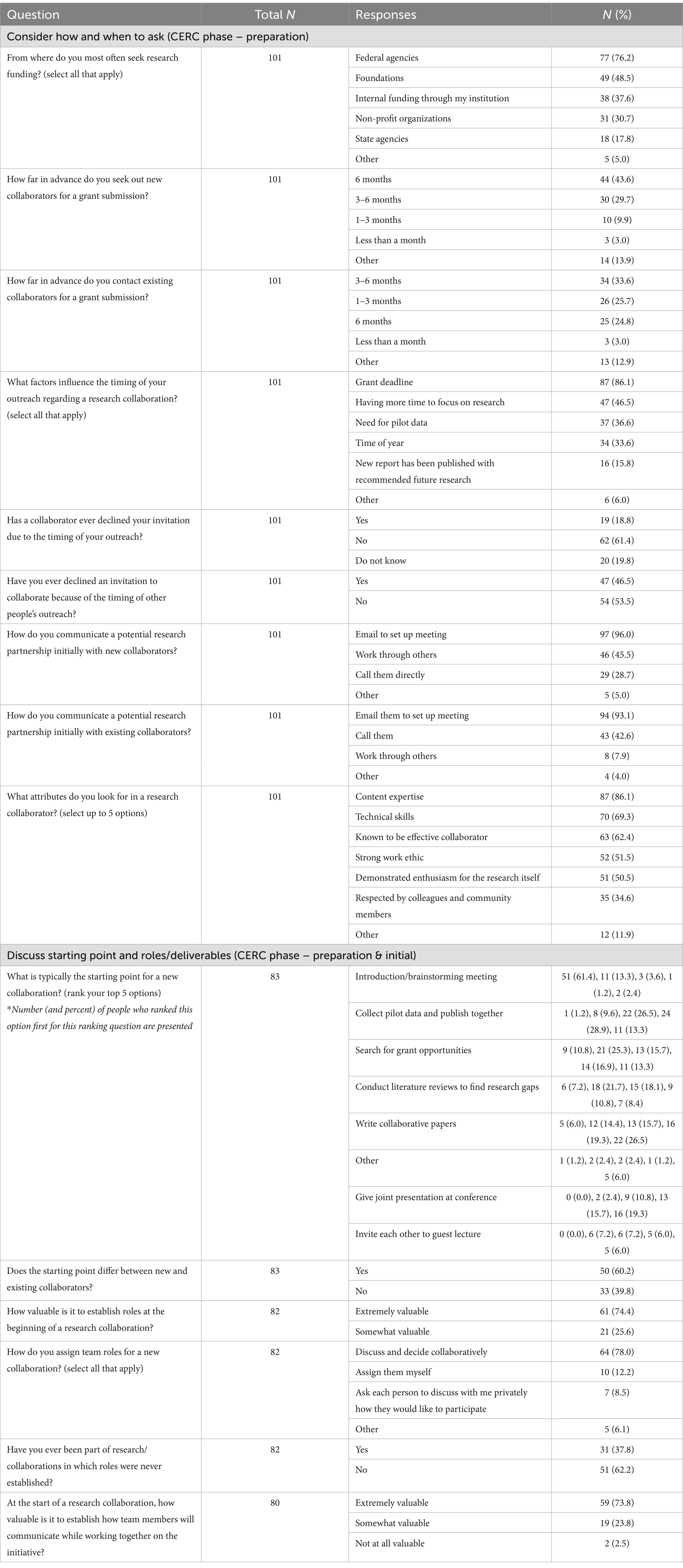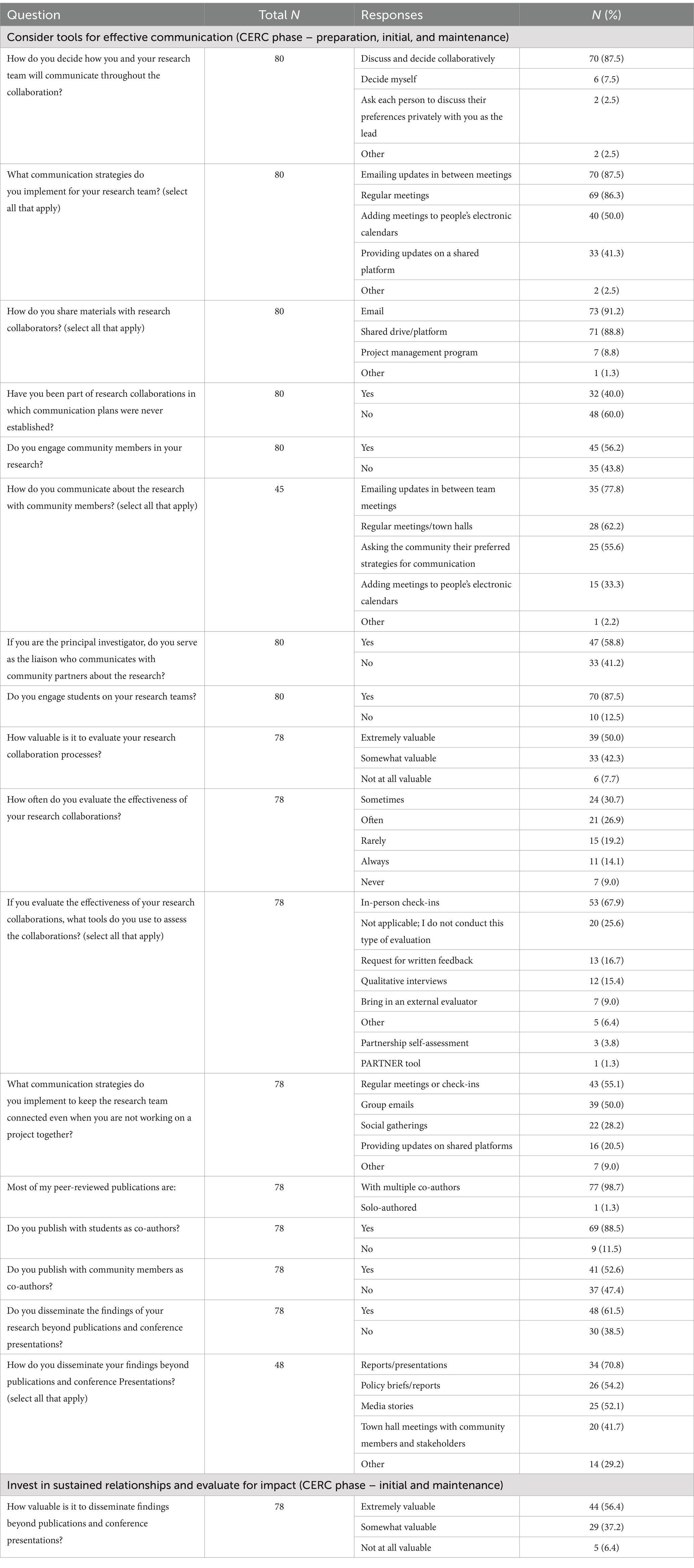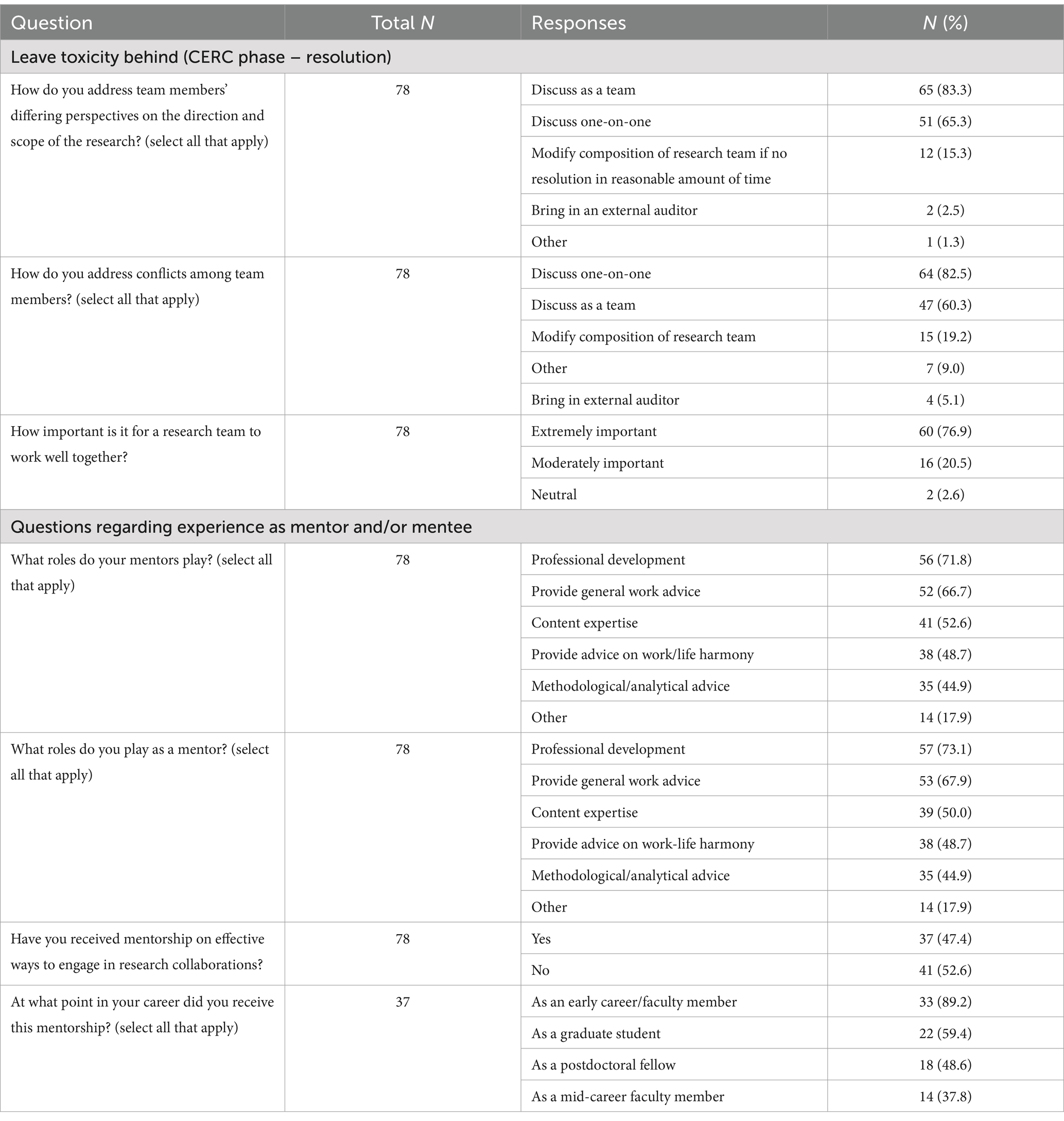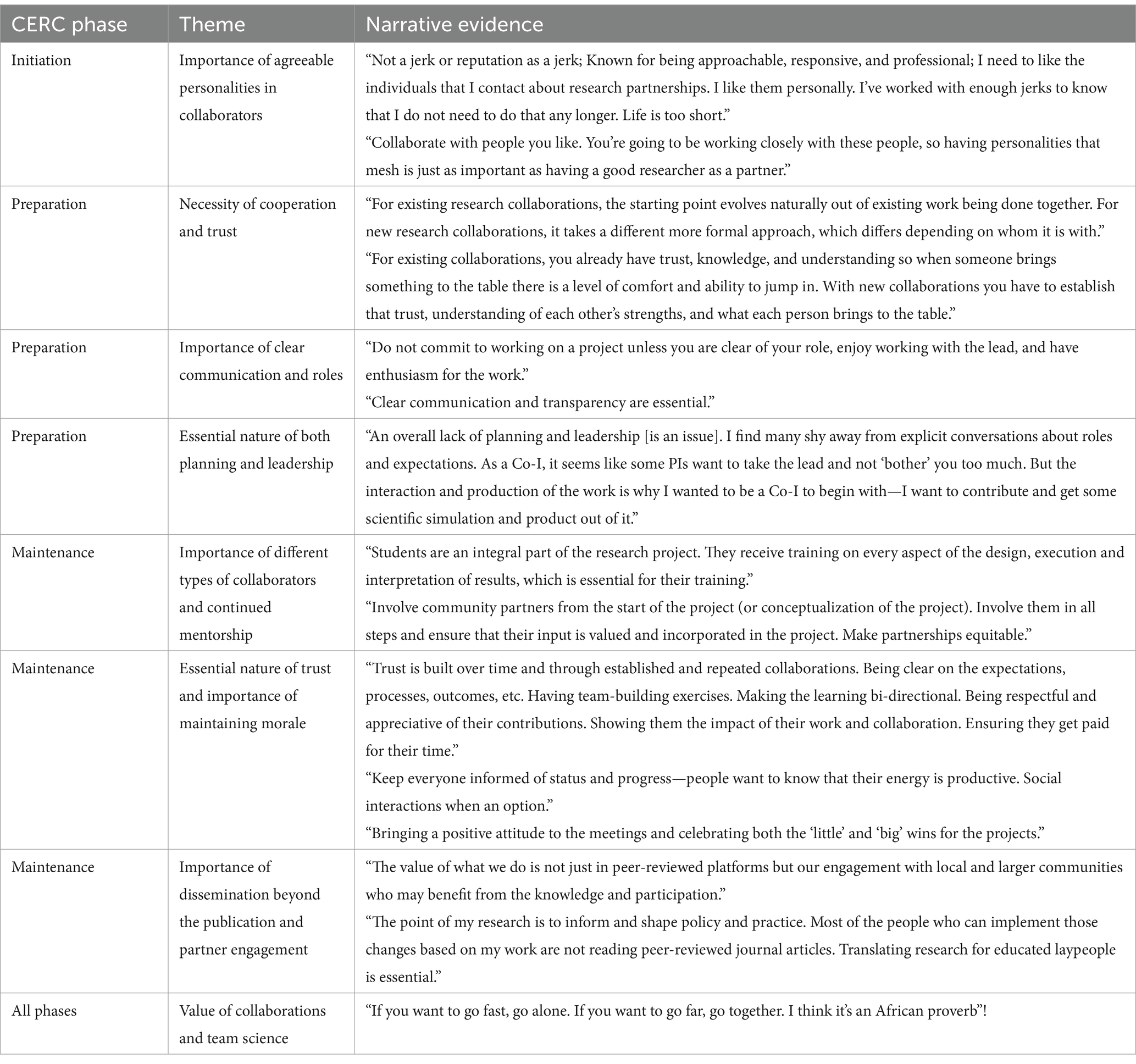- 1Arnold School of Public Health Department of Health Promotion, Education, and Behavior, Columbia, SC, United States
- 2Arnold School of Public Health Department of Environmental Health Sciences, Columbia, SC, United States
- 3Arnold School of Public Health Department of Communication Sciences and Disorders, Columbia, SC, United States
- 4South Carolina Honors College and College of Information and Communications, Harper College, Columbia, SC, United States
- 5Arnold School of Public Health Department of Epidemiology and Biostatistics and Cancer Prevention and Control Program, Columbia, SC, United States
- 6College of Nursing Department of Biobehavioral Health and Nursing Science, Columbia, SC, United States
- 7College of Social Work, Columbia, SC, United States
- 8College of Arts and Sciences, Baruch Institute for Marine and Coastal Sciences, Georgetown, SC, United States
Introduction: Guided by a communications-focused framework developed by an interdisciplinary team of authors, this paper presents data from a survey of health science faculty members to better understand how research collaborations are established and maintained.
Methods: An electronic survey was distributed to faculty in six colleges at a Research 1 institution. Quantitative data were downloaded into Excel and then RStudio for descriptive analysis. Open-ended, qualitative responses were coded and analyzed for themes.
Results: Most respondents were in public health (44.0%) or medicine (25.3%); 40.0% were tenured. A grant deadline was the main impetus reported for initiating research collaborations (86.1%). Most respondents (76.5%) sought federal research funding. Establishing roles at the start of collaborations was considered either extremely (74.4%) or somewhat (25.6%) valuable; most (78.0%) decided on roles in a collaborative manner. Women were significantly more likely than men to publish with community members (p < 0.001) and disseminate findings beyond journal publications or presentations (e.g., reports; p < 0.001). Individuals in public health were more likely than those in other disciplines to publish with community members (p = 0.026).
Discussion: Findings suggest reaching out to collaborators to prepare a grant application no later than three months and ideally six months in advance. Expertise played a role in collaborator invitation, but personal qualities such as work ethic and enthusiasm for the research were also valued. Including and mentoring students on research teams was considered an important ingredient in research collaborations. Results should help guide efforts to establish and maintain research teams and may provide guidance to both novice and experienced researchers.
Introduction
Clear, timely, tailored, and collaborative communication, which often mirrors health and risk communication principles, can guide the effective development, engagement with, and sustainability of research teams. The Seven (Cake) Layers to Research Team Development framework developed by Friedman et al. (2024) incorporates aspects of the Centers for Disease Control and Prevention’s (CDC) Crisis and Emergency Risk Communication (CERC) framework (Reynolds and Lutfy, 2018) and Nyström et al. (2018) Research Partnership Model.
Friedman et al.’s (2024) layers for building (aka ‘baking’) effective research teams involve conceptualization and initial planning steps through evaluation and sustainability. The seven layers are to: (1) find collaborators early on, (2), consider how and when you invite individuals to collaborate, (3) discuss a starting point for the collaboration, (4), establish clear deliverables for each collaborator and partner involved, (5), consider tools for effective team communication, (6) invest in relationships and evaluate the collaboration for improvement and sustainability, and (7) leave toxic collaborations behind.
Interestingly, each of the cake layers regarding the development, engagement with, and sustainability of research teams and partnerships aligns with health and risk communication principles. Specifically, this is apparent with the CDC’s CERC framework and best practices guide for individuals and organizations involved in responding to public health emergencies (Reynolds and Lutfy, 2018). All four main phases of a CERC response involve communication and they are referred to as the communication rhythm: Preparation (precrisis), Initial, Maintenance, and Resolution. Preparation involves establishing strong partnerships with stakeholders and organizations and the development of message content and plans for dissemination. The Initial phase includes clarifying messages, enhancing credibility and trustworthiness, and encouraging specific actions. Maintenance entails ongoing communication and encouraging public support and cooperation. Resolution involves continuing to motivate people, sharing lessons learned, and evaluating the entire communication process and actions. The three overarching objectives of CERC are to engage community, empower decision-making in others, and evaluate and reassess all activities. These objectives are also critical for effective research collaborations.
Nyström et al. (2018) also describe principles of preparation, process, and impact for health and social services partnerships. Their work is based partly on that of Rycroft-Malone et al. (2016) who stress process and practices, and specifically the importance of communication mechanisms for enhanced research impact. Whether relaying critical crisis information, building social service-focused community partnerships, or developing and maintaining research collaborations, the academic literature consistently maintains that effective, strategic communication is crucial for success (Friedman et al., 2014a; Friedman et al., 2014b; Friedman et al., 2014c; Friedman et al., 2016; Friedman et al., 2024).
Across all these frameworks, concepts such as awareness, knowledge, trust, authenticity, and connection are discussed as necessary components when attempting to shape attitudes, beliefs, and behaviors (Friedman et al., 2013; McCracken et al., 2013; Friedman et al., 2014c; Tanner et al., 2015; Tanner et al., 2016; Mathias et al., 2023). Clear, evidence-based communication practices, identified in the results presented here, are key to attaining these goals. By contrast, poor communication leads to confusion, resentment, lack of support, and ineffectiveness.
Much of the research conducted by our team is interdisciplinary. It also involves faculty members, research staff, and students at various ranks and levels of experience, and engages communities and community organizations (Freedman et al., 2012; Friedman et al., 2012b; Freedman et al., 2013; McCracken et al., 2013; Friedman et al., 2014a; Friedman et al., 2014b; Friedman et al., 2014c; Hébert et al., 2018; Friedman et al., 2019; Troy et al., 2022; Mathias et al., 2023). Often, given our team members’ prioritization of fostering and nurturing partnerships, it is also quite common for community members and organizations to reach out to the researchers for collaborative opportunities. In mentorship of faculty and students, it is vital to approach any and all community and organizational partnerships with care and mutual respect in order to ensure effective and sustained success and optimal impact (Tynan and Garbett, 2007; Hebert et al., 2009).
Team Science, which involves collaborations of professionals with diverse skills and knowledge who are often from different disciplines, is a closely related approach recommended for leading and facilitating research teams (National Cancer Institute Division of Cancer Control and Population Sciences, 2021). Good examples of this are found in collaborations within NCI-funded initiatives. The Community Networks Program entailed collaboration across 23 universities representing virtually every geographical region and all high-risk populations in the United States (Greiner et al., 2014; Adams et al., 2015; Hebert et al., 2015; Bevel et al., 2018). Because projects varied widely in terms of intervention content and measurement methods there was tremendous disciplinary diversity. However, all were focused on conducting research according to the principles of community-based participatory research (CBPR) (Hebert et al., 2009; Braun et al., 2012). Another example of the team science approach is the MeDOC (Metabolic Dysregulation and Cancer Risk Program) Consortium, which focuses on metabolic dysregulation as the fundamental substrate on which most cancer-related mechanisms operate (Lam et al., 2024). This consists of five sites (Universities of Utah, Memphis, Iowa, South Carolina, and Harvard University) and a coordinating center at George Washington University. Each site works on a different part of the cancer problem; for example, different anatomic sites (breast, colon/rectum, liver) and specific mechanisms (e.g., microbiome-related, fatty acid and sphingolipid metabolism, inflammotypes). Despite this heterogeneity, the network has successfully harmonized much of the data collection across centers. Furthermore, the MeDOC consortium stresses both mentoring individuals early on in their career and CBPR/community engagement, with a purposeful intersection between the two.
In follow up to the framework developed by this interdisciplinary research team (Friedman et al., 2024), we surveyed academic-based researchers to better understand how they identify and engage with research collaborators and partners, establish processes for collaborations, sustain research teams and partnerships, and disseminate their work. The survey was administered to faculty within six colleges at the authors’ university.
Materials and methods
Recruitment of survey respondents
Recruitment was conducted in the United States at a Research 1 (Carnegie Foundation designation) institution across six academic colleges (information and communications, nursing, medicine, pharmacy, public health, and social work). We selected these colleges because the authors’ collaborative scholarship is in health sciences and/or health communication. Authors contacted research deans in these colleges with a request to distribute the electronic survey with a cover email via their faculty listservs. The survey was distributed on February 13, 2024, with two reminders during the weeks of February 26 and March 11. The survey closed on March 15, 2024.
Participation in the 20-min survey was anonymous. Respondents were entered to win one of five $50 gift cards for completing the survey. Those who completed the survey were also invited to participate in a one-hour workshop on research team building, which was developed and conducted by the authors and guided by the results of this research. A video recording of the workshop was also created to further disseminate results. If respondents were interested in entering the gift card drawing and/or participating in the workshop, they were directed to a separate portal upon completing the survey and asked for their name and email address. The provision of this contact information was not linked to survey responses. All aspects of this study were approved by the university’s Institutional Review Board.
Survey development and content
An iterative approach to survey item development was employed with two team members drafting an initial list of questions and then all team members contributing to multiple versions of the electronic survey. Survey questions were grouped according to the seven author-developed steps and Crisis and Emergency Risk Communication (CERC) phases described earlier (Reynolds and Lutfy, 2018). Table 1 presents the number and type of question by layer and phase.
In addition to the questions guided by our seven-layer framework, we were interested in learning about respondents’ experiences as a research mentor and/or mentee and their experiences engaging community members and students in research collaborations. We also asked questions about the respondents themselves: gender, age, race, ethnicity, number of years at current institution, current academic rank and track, academic unit/discipline, whether they had an administrative role, and appointment type.
Data analysis
The survey was formatted in and administered via Qualtrics (2020). Quantitative data were downloaded into Excel and then RStudio (RStudio Team, 2020) for descriptive statistical analysis (frequencies, percentages, chi-square tests to examine relationships between variables). Open-ended, qualitative responses were imported separately into Excel for organization and analysis by two team members with expertise in qualitative methodology and thematic analysis. The two team members independently coded data for codebook development (Corbin and Strauss, 2014) and met to discuss the codes and codebook until they reached 100% agreement. They then adapted the codebook where needed. One team member confirmed and finalized the remainder of the coding into broader themes and pulled representative quotes for presentation of themes by CERC phase (Patton, 2014).
Results
In order to estimate an overall potential respondent pool, we collected data on total number of faculty members by track in each of the colleges represented so we could get a good sense of the number of faculty conducting and/or expected to be conducting research (i.e., tenured/tenure track and research faculty) by college/ school. Table 2 presents Spring 2024 data on number of faculty members by track in each college who would be expected to conduct research.
With 156 faculty researchers responding to the survey, the response rate was 51.6%, based on the total number of tenure track and research track faculty numbers across colleges (n = 267). The response rate to different survey questions varied as not all questions were required, particularly demographic questions.
Respondent demographics
Most individuals who responded to the demographic questions (n = 77) were White (76.6%), female (58.4%), and non-Hispanic or non-Latino (83.1%). The age range of respondents was 29 to 77 years, with an average age of 49.0 (SD 11.9) years. Most respondents were in public health (44.0%) or medicine (25.3%). The approximate number of years at the institution varied greatly, from 1.5 to 39 years, with an average of 10.5 (SD 8.9). Many were full professors (36.0%) or assistant professors (30.7%); 40.0% were tenured faculty members. Table 3 summarizes additional demographic data of survey respondents.
Preparation phase
Almost all respondents (88.5% or 138/156) indicated they were currently or previously engaged in research. They knew collaborators mainly from past research projects, for both prior research initiatives (71.1% or 81/114) and current ones (65.8% or 71/114). Table 4 displays questions and responses about preparation for collaboration.
Initiation phase
Most respondents (76.2% or 77/101) sought research funding from federal agencies (Table 5). Very few (4.4%) did not seek out any funding for their research initiatives. Most respondents knew either prior (71.1%) or current (65.8%) research partners from past collaborations (Table 4). They generally sought out new collaborators at least six months prior to a grant deadline (43.6%); this was between three to six months if they were going to contact prior/existing collaborators for a grant submission opportunity (33.6%). Grant deadlines greatly affected when respondents (86.1%) sought out collaborators. Several respondents (46.5%) declined invitations if the timing of outreach from others was not suitable and, therefore, they felt too rushed. They indicated, however, that few of their collaborators (18.8%) declined invitations based on the timing of outreach for their collaboration. Email was the most preferred communication method to set up new (96.0%) or existing (93.1%) collaborations (Table 5).
Content expertise (86.1%) and technical skills (69%) were the most preferred attributes in collaborators. Most respondents (61.4%) initiated collaboration with introductory or brainstorming meetings, followed by searching for grant opportunities (25.3%), and conducting literature reviews (21.7%). Starting points tended to differ between new and existing collaborations, according to 60.0% of respondents. When seeking out new collaborators, respondents focused on candidates with cooperative personalities who were tenacious, diligent, and thorough in work duties. Respondents reported that establishing roles at the start of collaborations was either extremely (74.4%) or somewhat (25.6%) valuable, and most (78.0%) responded that they discussed and decided on roles in a collaborative manner. Many elaborated on the close-ended question of “Have you ever been a part of a collaboration in which roles were never established”? when asked “Why did you think the roles were never established”? Responses were quite varied, ranging from lack of time to not thinking it was their responsibility to establish roles. One individual shared, “It was not important to the PI (principal investigator)/lead of the project to clearly delineate roles”.
Respondents also indicated the importance of establishing communication methods upfront for the collaboration; 73.8% considered it extremely valuable. Table 5 presents findings regarding research team initiation and role establishment.
Maintenance phase
Maintaining collaborations was achieved through continued communication and research dissemination. Email was the most preferred tool for maintaining communication among team members (87.5% or 70/80) and was used specifically to share material with research collaborators (91.2%) or to send updates to community members in between team meetings (77.8%).
The majority of respondents (87.5%) engaged students in their research. Over half (56.2%) also engaged community members. Of these (n = 80), over half (58.8%) served as the liaison who communicated with community members about the research. Almost all respondents (98.7%) wrote papers with multiple co-authors. Respondents had an average of five co-authors (SD 2.8, range 1–20). Over half of respondents specifically involved students (88.5%) or community members (52.6%) as co-authors. Women and those in Public Health were more likely than men [χ2 (df = 2, N = 77) = 25.1, p < 0.001] and those in other disciplines [χ2 (df = 2, N = 75) = 15.9, p = 0.03], to publish with community members.
Almost two-thirds (61.5%) also shared their research findings beyond publications and conference presentations. Specifically, 70.8% disseminated information through other types of reports/presentations, 54.2% as policy briefs, and 54.2% via media pieces. Over half (56.4%) considered dissemination of information beyond publications or conference presentations extremely valuable, and 37.2% considered it somewhat valuable. Women were more likely to engage in research dissemination beyond the traditional methods of publication and presentation than men [χ2 (df = 2, N = 77) = 18.2, p < 0.001].
Half of respondents (50%) considered evaluation of collaboration processes to be extremely valuable. Correspondingly, the frequency of evaluations varied greatly with 30.7% conducting evaluations sometimes, 26.9% performing evaluations often, and 19.2% rarely conducting evaluations. Of those who conducted evaluations, slightly over two-thirds (n = 78, 67.9%) used regular meetings or check-ins to assess the effectiveness of their research processes. Over half (55.1%) also used regular meetings or check-ins to keep their research teams connected even when working remotely.
Table 6 summarizes responses regarding processes used throughout the research process.
Resolution phase and mentorship
Overall, most respondents valued the importance of discussing differing perspectives/conflicts as a team (83.3% or 65/78) or one-on-one (65.3%), although they indicated that such conflicts were rare. Most (76.9%) stressed the importance of teams working well together.
Respondents offered that they received mentorship from faculty members, doctoral advisors, major professors, or colleagues either early in their faculty career (89.2%) or during graduate school (59.4%). The number of mentors that respondents reported ranged from zero to nine (avg. 1.8, SD 1.8). Just under half (47.4%) had been mentored in how to develop and engage in effective research collaborations. Women were more likely than men to report having received mentorship [χ2 (df = 2, N = 77) = p < 0.001].
Respondents also served as mentors and the number of mentees they reported ranged from zero to 15 (avg. 2.5, SD 3.2). They most often coached others in professional development (73.1%) and provided general work advice (67.9%). Table 7 summarizes these findings.
Findings from open-ended questions
Respondents reported that essential qualities of effective collaborations were cooperation, organized planning, role establishment, leadership, and trust. Overall, respondents valued the support and efforts of students and community members. They also indicated the importance of maintaining morale during collaborations. Effective collaboration was also necessary for sharing scientific knowledge beyond publications into the communities who were research partners from the outset. Table 8 summarizes major themes by CERC research collaboration phase and representative quotes for each. Note that multiple themes are evident in several quotes.
Discussion
Effective collaboration among researchers is essential for productive team science and scientific progress (Steer et al., 2017; Tebes, 2018; Altman et al., 2020; Ezenwa et al., 2024). Such collaborative and interdisciplinary efforts are vital, especially with increasingly prevalent diverse public health concerns, including pandemics, an aging population (Sukoff Rizzo et al., 2023), and climate change (Bruine de Bruin and Morgan, 2019; Herzig Van Wees et al., 2019; Ridde et al., 2019). As interdisciplinary research has become more of a norm for meaningful health impacts (Galway et al., 2016), understanding how to initiate collaborations and address any difficulties with such collaborative efforts can aid conflict management and effective communication (Selker and Wilkins, 2017; Begerowski et al., 2021; Sukoff Rizzo et al., 2023).
The experiences shared in the current study could be helpful to researchers who are seeking to develop research collaborations or seek grant funding. The current sample included a significant portion of experienced researchers (40% of tenured faculty and 36% who were full professors) at a Research 1 University. Initiating a research collaboration was carried out most often with an introduction or brainstorming meeting. In a time during which we have a variety of communication channels, management platforms, etc., basic email was still the primary form of communication for faculty researchers, along with good-old-fashioned face-to-face meetings.
Several approaches for identifying possible team members were shared by respondents in the current study: reach out to known collaborators, create opportunities to meet new collaborators, and the ask-around approach appear to be ways to create research teams. In all cases, it is ideal to start the search early (Consalvey, 2023). Most researchers in our study were mainly working with those they knew and with whom they had a relationship, and they tended to go back to those same individuals for subsequent collaborations. However, networking to find teams of researchers you work well with and enjoy working with is a key strategy for junior faculty members. Content and research expertise was found to be important, but other attributes of collaborators were considered just as critical, and they can indeed make someone valuable to a team. Technical skills are highly sought after, as is someone with a good reputation who is easy to work with and who has a strong work ethic.
Respondents recognized the necessity of planning and strong leadership for research collaborations, as well as the importance of cooperation and trust. Effective leadership involved providing clear and timely guidance, being trustworthy, and mentoring and welcoming students and junior faculty onto teams for different viewpoints and skillsets (Friedman et al., 2024). Mentorship – having mentors and also serving as a mentor – was important to respondents, not just for sharing knowledge of a content area, but particularly to help navigate professionally and provide career advice (Friedman et al., 2021; Johnson et al., 2022). Mentorship can help with networking and establishing oneself on a research team as a student or junior faculty member.
Women were significantly more likely than men to publish with community members and disseminate findings beyond publications or presentations (e.g., reports, media sources). Other studies have found similar results with regard to gender differences in research collaborations (Abramo et al., 2013; Zeng et al., 2016). Abramo et al. (2013) indicated that women in disciplines such as medicine and physics were more likely to collaborate in research than their male counterparts. Zeng et al. (2016) found similar results across disciplines but noted women generally had fewer co-authors on peer-reviewed publications.
While we are often quick to move on to the next project instead of assessing and reflecting on our current initiatives, evaluation of collaborations is important for team cohesion and longevity (Friedman et al., 2012a; Friedman et al., 2014c; Soltani et al., 2017; Johnson et al., 2022; Friedman et al., 2024). Only half of respondents regularly engaged in this type of evaluation, though they did recognize the need to address team conflict even if this was an uncomfortable task (Friedman et al., 2014c; Soltani et al., 2017). Taking the time to reflect on the process of collaboration, including communication strategies and role establishment, can lead to long-term and sustainable partnerships. In addition, reported team-building experiences included collecting pilot data, publishing together, searching for grant opportunities, conducting literature reviews to identify gaps in knowledge, and co-presenting at conferences.
Limitations
Despite its strengths, this study had limitations. One major question is related to the matter of self-response bias. Respondents differ from non-respondents and often in nonobvious ways. Future research needs to take into account that non-respondents also conduct research. Are they less collaborative? Successful? Did they differ on demographic parameters? For example, women were more likely to be respondents, but they do not constitute three quarters of our faculty. Are they better communicators and collaborators? It will be important to understand our true denominators and how that relates to communication, engagement and, ultimately, both research productivity and broader-scale relevance (e.g., in satisfying the public health imperative to serve the greatest need).
The response rate to survey questions also dropped as individuals completed the survey as not all questions were forced response. Such small sample sizes hinder generalizations that can be made beyond this particular sample of faculty members at one research institution in health sciences and communication units. Furthermore, the statistically significant results must be interpreted with caution due to the small sample and cell sizes. Some questions, including those about gender, race, and ethnicity, included a “Prefer not to answer” response, which further decreased our ability to analyze the data further. However, given that this was a survey administrated with the authors’ own colleagues at their institution, providing the option of “prefer not to answer” was important so that individuals would feel comfortable participating in the study and sharing their experiences and perceptions. Minoritized groups are often underrepresented in biomedical and health sciences research and may not want to share details about their work experiences (Phillips et al., 2018; Levites Strekalova et al., 2021).
Conclusions and future directions
As the current research was a pilot study at one institution, additional research questions concerning research collaborations need to be explored with a larger, more generalizable population. Results clearly indicate the necessity of cooperation, trust, leadership, and establishing roles and communication in any research collaboration. The value of continued mentorship was also evident. Guided by findings from survey results and based on the authors’ published framework (Friedman et al., 2024), the team developed a workshop on effective research team development. This was offered for those who expressed interest when completing the survey and for other interested faculty members and recorded for future use.
Furthermore, increasing research productivity is also a common goal among universities that are not Research 1 institutions. It is important to consider how faculty at other universities may respond to the same survey, especially if the broader goal is to diversify the research pool of investigators. Finally, involving community partners as collaborators was endorsed by a significant number of respondents and future research will examine partners’ perspectives on research team development and sustainability.
Data availability statement
The datasets presented in this article are not readily available, however, deidentifiable survey data are available upon reasonable request from the corresponding author. Requests to access the datasets should be directed to DF, ZGZyaWVkbWFAbWFpbGJveC5zYy5lZHU=.
Ethics statement
The studies involving humans were approved by University of South Carolina Office of Research Compliance. The studies were conducted in accordance with the local legislation and institutional requirements. Written informed consent for participation was not required from the participants or the participants’ legal guardians/next of kin because this was not required for this survey.
Author contributions
DF: Conceptualization, Data curation, Formal analysis, Methodology, Project administration, Supervision, Validation, Writing – original draft, Writing – review & editing. CE: Formal analysis, Writing – original draft, Writing – review & editing. JN-S: Conceptualization, Formal analysis, Methodology, Writing – original draft, Writing – review & editing. AT: Conceptualization, Formal analysis, Methodology, Writing – original draft, Writing – review & editing. JH: Conceptualization, Formal analysis, Methodology, Writing – original draft, Writing – review & editing. LD: Conceptualization, Formal analysis, Methodology, Writing – original draft, Writing – review & editing. SL: Conceptualization, Formal analysis, Methodology, Writing – original draft, Writing – review & editing. FH: Data curation, Formal analysis, Methodology, Software, Writing – review & editing. BY: Validation, Writing – original draft, Writing – review & editing. DP: Conceptualization, Data curation, Formal analysis, Methodology, Validation, Writing – original draft, Writing – review & editing.
Funding
The author(s) declare that no financial support was received for the research, authorship, and/or publication of this article.
Acknowledgments
The authors thank all those who took the time to complete this survey and share their research team building experiences.
Conflict of interest
The authors declare that the research was conducted in the absence of any commercial or financial relationships that could be construed as a potential conflict of interest.
The author(s) declared that they were an editorial board member of Frontiers, at the time of submission. This had no impact on the peer review process and the final decision.
Publisher’s note
All claims expressed in this article are solely those of the authors and do not necessarily represent those of their affiliated organizations, or those of the publisher, the editors and the reviewers. Any product that may be evaluated in this article, or claim that may be made by its manufacturer, is not guaranteed or endorsed by the publisher.
References
Abramo, G., D’Angelo, C., and Murgia, G. (2013). Gender differences in research collaboration. J. Informetr. 7, 811–822. doi: 10.1016/j.joi.2013.07.002
Adams, S. A., Heiney, S. P., Brandt, H. M., Wirth, M. D., Khan, S., Johnson, H., et al. (2015). A comparison of a centralized versus de-centralized recruitment schema in two community-based participatory research studies for cancer prevention. J. Community Health 40, 251–259. doi: 10.1007/s10900-014-9924-9
Altman, K., Yelton, B., Hart, Z., Carson, M., Schandera, L., Kelsey, R. H., et al. (2020). You gotta choose your words carefully”: findings from interviews with environmental health scientists about their research translation perceptions and training needs. J. Health Commun. 25, 454–462. doi: 10.1080/10810730.2020.1785060
Begerowski, S. R., Traylor, A. M., Shuffler, M. L., and Salas, E. (2021). An integrative review and practical guide to team development interventions for translational science teams: one size does not fit all. J Clin Transl Sci 5:e198. doi: 10.1017/cts.2021.832
Bevel, M., Babatunde, O. A., Heiney, S. P., Brandt, H. M., Wirth, M. D., Hurley, T. G., et al. (2018). Sistas inspiring Sistas through activity and support (SISTAS): study design and demographics of participants. Ethn. Dis. 28, 75–84. doi: 10.18865/ed.28.2.75
Braun, K. L., Nguyen, T. T., Tanjasiri, S. P., Campbell, J., Heiney, S. P., Brandt, H. M., et al. (2012). Operationalization of community-based participatory research principles: assessment of the national cancer institute's community network programs. Am. J. Public Health 102, 1195–1203. doi: 10.2105/AJPH.2011.300304
Bruine de Bruin, W., and Morgan, M. G. (2019). Reflections on an interdisciplinary collaboration to inform public understanding of climate change, mitigation, and impacts. Proc. Natl. Acad. Sci. USA 116, 7676–7683. doi: 10.1073/pnas.1803726115
Consalvey, M. (2023). A funding adviser's guide to writing a great grant application. Nature 621, 883–884. doi: 10.1038/d41586-023-02756-6
Corbin, J., and Strauss, A. (2014). Basics of qualitative research. 3rd Edn. Thousand Oaks, CA: Sage Publications.
Ezenwa, M. O., Smith, T. B., Richey, J., Smith, U. D., Stern, M. C., Reams, R., et al. (2024). Social network analysis of theCaRE2health equity center: team science in full display. Clin. Transl. Sci. 17:e13747. doi: 10.1111/cts.13747
Freedman, D. A., Choi, S. K., Hurley, T., Anadu, E., and Hebert, J. R. (2013). A farmers' market at a federally qualified health center improves fruit and vegetable intake among low-income diabetics. Prev. Med. 56, 288–292. doi: 10.1016/j.ypmed.2013.01.018
Freedman, D. A., Whiteside, Y. O., Brandt, H. M., Young, V., Friedman, D. B., and Hebert, J. R. (2012). Assessing readiness for establishing a farmers' market at a community health center. J. Community Health 37, 80–88. doi: 10.1007/s10900-011-9419-x
Friedman, D. B., Adams, S. A., Brandt, H. M., Heiney, S. P., Hebert, J. R., Ureda, J. R., et al. (2019). Rise up, get tested, and live: an arts-based colorectal cancer educational program in a faith-based setting. J. Cancer Educ. 34, 550–555. doi: 10.1007/s13187-018-1340-x
Friedman, D. B., Bergeron, C. D., Foster, C., Tanner, A., and Kim, S. H. (2013). What do people really know and think about clinical trials? A comparison of rural and urban communities in the south. J. Community Health 38, 642–651. doi: 10.1007/s10900-013-9659-z
Friedman, D. B., Brandt, H. M., Freedman, D. A., Adams, S. A., Young, V. M., Ureda, J. R., et al. (2014a). Innovative and community-driven communication practices of the South Carolina cancer prevention and control research network. Prev. Chronic Dis. 11:E127. doi: 10.5888/pcd11.140151
Friedman, D. B., Donelle, L., Levkoff, S. E., Neils-Strunjas, J., Porter, D. E., Tanner, A., et al. (2024). Mentoring in developing, engaging with, and sustaining research teams that aligns with health and risk communication principles: apples and oranges or apples and apples? Mentoring & Tutoring: Partnership in Learning. Mentor. Tutor. 32, 94–113. doi: 10.1080/13611267.2023.2299383
Friedman, D. B., Freedman, D. A., Choi, S. K., Anadu, E. C., Brandt, H. M., Carvalho, N., et al. (2014b). Provider communication and role modeling related to patients' perceptions and use of a federally qualified health center-based farmers' market. Health Promot. Pract. 15, 288–297. doi: 10.1177/1524839913500050
Friedman, D. B., Johnson, K. M., Owens, O. L., Thomas, T. L., Dawkins, D. S., Gansauer, L., et al. (2012a). Developing partnerships and recruiting dyads for a prostate cancer informed decision making program: lessons learned from a community-academic-clinical team. J. Cancer Educ. 27, 243–249. doi: 10.1007/s13187-012-0353-0
Friedman, D. B., Owens, O. L., Jackson, D. D., Johnson, K. M., Gansauer, L., Dickey, J., et al. (2014c). An evaluation of a community-academic-clinical partnership to reduce prostate cancer disparities in the south. J. Cancer Educ. 29, 80–85. doi: 10.1007/s13187-013-0550-5
Friedman, D. B., Wilcox, S., and Hebert, J. R. (2016). Proposing an interdisciplinary, communication-focused agenda for Cancer and aging researchers. J. Cancer Educ. 31, 218–220. doi: 10.1007/s13187-015-0822-3
Friedman, D. B., Yelton, B., Corwin, S. J., Hardin, J. W., Ingram, L. A., Torres-McGehee, T. M., et al. (2021). Value of peer mentorship for equity in higher education leadership: a school of public health focus with implications for all academic administrators. Mentor. Tutor. 29, 500–521. doi: 10.1080/13611267.2021.1986795
Friedman, D. B., Young, V. M., Freedman, D. A., Adams, S. A., Brandt, H. M., Xirasagar, S., et al. (2012b). Reducing cancer disparities through innovative partnerships: a collaboration of the South Carolina Cancer prevention and control research network and federally qualified health centers. J. Cancer Educ. 27, 59–61. doi: 10.1007/s13187-011-0272-5
Greiner, K. A., Friedman, D. B., Adams, S. A., Gwede, C. K., Cupertino, P., Engelman, K. K., et al. (2014). Effective recruitment strategies and community-based participatory research: community networks program centers' recruitment in cancer prevention studies. Cancer Epidemiol. Biomarkers Prev. 23, 416–423. doi: 10.1158/1055-9965.EPI-13-0760
Hébert, J., Adams, S. A., Ureda, J. R., Young, V. M., Brandt, H. M., Heiney, S. P., et al. (2018). Accelerating research collaborations between academia and federally qualified health centers: suggestions shaped by history. Public Health Rep. 133, 22–28. doi: 10.1177/0033354917742127
Hebert, J. R., Brandt, H. M., Armstead, C. A., Adams, S. A., and Steck, S. E. (2009). Interdisciplinary, translational, and community-based participatory research: finding a common language to improve cancer research. Cancer Epidemiol. Biomarkers Prev. 18, 1213–1217. doi: 10.1158/1055-9965.EPI-08-1166
Hebert, J. R., Braun, K. L., Meade, C. D., Bloom, J., and Kobetz, E. (2015). Community-based participatory research adds value to the National Cancer Institute's research portfolio. Prog. Community Health Partnersh. 9, 1–4. doi: 10.1353/cpr.2015.0022
Herzig Van Wees, S. L., Målqvist, M., and Irwin, R. (2019). Achieving the SDGs through interdisciplinary research in global health. Scand. J. Public Health 47, 793–795. doi: 10.1177/1403494818812637
Johnson, C. L., Friedman, D. B., Ingram, L. A., Ford, M. E., McCrary-Quarles, A., Dye, C. J., et al. (2022). Reflections on mentorship from scientists and mentors in an Alzheimer's disease focused research training program. J. Appl. Gerontol. 41, 2307–2315. doi: 10.1177/07334648221109514
Lam, T., Daschner, P., Ishibe, N., Wali, A., Hall, K., Czajkowski, S., et al. (2024). Metabolic dysregulation and cancer risk program (MeDOC): a transdisciplinary approach to obesity-associated cancers. J. Natl. Cancer Inst. 116, 1555–1561. doi: 10.1093/jnci/djae134
Levites Strekalova, Y. A., Qin, Y. S., Sharma, S., Nicholas, J., McCaslin, G. P., Forman, K. E., et al. (2021). The black voices in research curriculum to promote diversity and inclusive excellence in biomedical research. J. Clin. Transl. Sci. 5:e206. doi: 10.1017/cts.2021.869
Mathias, W., Nichols, K. A., Golden-Wright, J., Fairman, C. M., Felder, T. M., Workman, L., et al. (2023). Implementation during a pandemic: findings, successes, and lessons learned from community grantees. J. Cancer Educ. 38, 957–962. doi: 10.1007/s13187-022-02213-4
McCracken, J. L., Friedman, D. B., Brandt, H. M., Adams, S. A., Xirasagar, S., Ureda, J. R., et al. (2013). Findings from the community health intervention program in South Carolina: implications for reducing cancer-related health disparities. J. Cancer Educ. 28, 412–419. doi: 10.1007/s13187-013-0479-8
National Cancer Institute Division of Cancer Control and Population Sciences (2021). Team Science ToolKit [Online]. Available at: https://cancercontrol.cancer.gov/brp/research/team-science-toolkit
Nyström, M. E., Karltun, J., Keller, C., and Andersson Gäre, B. (2018). Collaborative and partnership research for improvement of health and social services: Researcher's experiences from 20 projects. HARPS 16:46. doi: 10.1186/s12961-018-0322-0
Galway, L. P., Parkes, M. W., Allen, D., and Takaro, T. K. (2016). Building interdisciplinary research capacity: a key challenge for ecological approaches in public health. AIMS Public Health 3, 389–406. doi: 10.3934/publichealth.2016.2.389
Patton, M. Q. (2014). Qualitative research and evaluation methods: Integrating theory and practice. 4th Edn. Thousand Oaks, CA: Sage Publications.
Phillips, K. W., Dumas, T. L., and Rothbard, N. P. (2018). Diversity and authenticity: minorities hesitate to share information about themselves at work. That’s a problem for everyone. Harvard Business Review March-April. Available at: https://hbr.org/2018/03/diversity-and-authenticity
Qualtrics (2020). Qualtrics XM [Online]. Provo, Utah. Available at: https://www.qualtrics.com
RStudio Team (2020). RStudio: Integrated development for R [online]. Boston, MA. Available at: http://www.rstudio.com/ (Accessed July 1, 2024).
Reynolds, B., and Lutfy, C. (2018). Crisis and emergency risk communication manual (updated 2018) [online]. Available at: https://emergency.cdc.gov/cerc/manual/index.asp
Ridde, V., Benmarhnia, T., Bonnet, E., Bottger, C., Cloos, P., Dagenais, C., et al. (2019). Climate change, migration and health systems resilience: need for interdisciplinary research. F1000Research 8:22. doi: 10.12688/f1000research.17559.2
Rycroft-Malone, J., Burton, C. R., Wilkinson, J., Harvey, G., McCormack, B., Baker, R., et al. (2016). Collective action for implementation: a realist evaluation of organisational collaboration in healthcare. Implement. Sci. 11:17. doi: 10.1186/s13012-016-0380-z
Selker, H. P., and Wilkins, C. H. (2017). From community engagement, to community-engaged research, to broadly engaged team science. J. Clin. Transl. Sci. 1, 5–6. doi: 10.1017/cts.2017.1
Soltani, S. N., Kannaley, K., Tang, W., Gibson, A., Olscamp, K., Friedman, D. B., et al. (2017). Evaluating community–academic partnerships of the South Carolina healthy brain research network. Health Promot. Pract. 18, 607–614. doi: 10.1177/1524839917700086
Steer, C. J., Jackson, P. R., Hornbeak, H., McKay, C. K., Sriramarao, P., and Murtaugh, M. P. (2017). Team science and the physician–scientist in the age of grand health challenges. Ann. N. Y. Acad. Sci. 1404, 3–16. doi: 10.1111/nyas.13498
Sukoff Rizzo, S. J., Finkel, T., Greenspan, S. L., Resnick, N. M., and Brach, J. S. (2023). Speaking the same language: team science approaches in aging research for integrating basic and translational science with clinical practice. Aging 7:igad035. doi: 10.1093/geroni/igad035
Tanner, A., Bergeron, C. D., Zheng, Y., Friedman, D. B., Kim, S. H., and Foster, C. B. (2016). Communicating effectively about clinical trials with african american communities. Health Promot. Pract. 17, 199–208. doi: 10.1177/1524839915621545
Tanner, A., Kim, S. H., Friedman, D. B., Foster, C., and Bergeron, C. D. (2015). Promoting clinical research to medically underserved communities: current practices and perceptions about clinical trial recruiting strategies. Contemp. Clin. Trials 41, 39–44. doi: 10.1016/j.cct.2014.12.010
Tebes, J. K. (2018). Team science, justice, and the co-production of knowledge. Am. J. Community Psychol. 62, 13–22. doi: 10.1002/ajcp.12252
Troy, C., Brunson, A., Goldsmith, A., Noblet, S., Steck, S. E., Hebert, J. R., et al. (2022). Implementing community-based prostate cancer education in rural South Carolina: a collaborative approach through a statewide cancer alliance. J. Cancer Educ. 37, 163–168. doi: 10.1007/s13187-020-01800-7
Tynan, B. R., and Garbett, D. L. (2007). Negotiating the university research culture: collaborative voices of new academics. High. Educ. Res. Dev. 26, 411–424. doi: 10.1080/07294360701658617
Keywords: faculty development, research mentorship, health and risk communication, professional development, interdisciplinary team building
Citation: Friedman DB, Ek C, Neils-Strunjas J, Tanner A, Hebert JR, Donelle L, Levkoff SE, Hucek FA, Yelton B and Porter DE (2025) “Courtesy, respect, and follow through”: a mixed methods evaluation of faculty members’ experiences, needs, and approaches to research collaborations. Front. Educ. 9:1493313. doi: 10.3389/feduc.2024.1493313
Edited by:
Isola Ajiferuke, Western University, CanadaReviewed by:
Karin Joann Opacich, University of Illinois Chicago, United StatesJacquelaine Florindo Borges, Federal University of Uberlandia, Brazil
Copyright © 2025 Friedman, Ek, Neils-Strunjas, Tanner, Hebert, Donelle, Levkoff, Hucek, Yelton and Porter. This is an open-access article distributed under the terms of the Creative Commons Attribution License (CC BY). The use, distribution or reproduction in other forums is permitted, provided the original author(s) and the copyright owner(s) are credited and that the original publication in this journal is cited, in accordance with accepted academic practice. No use, distribution or reproduction is permitted which does not comply with these terms.
*Correspondence: Daniela B. Friedman, ZGJmcmllZG1hbkBzYy5lZHU=
†ORCID: Daniela B. Friedman, https://orcid.org/0000-0002-9359-093X
 Daniela B. Friedman
Daniela B. Friedman Christina Ek1,2
Christina Ek1,2 Jean Neils-Strunjas
Jean Neils-Strunjas Lorie Donelle
Lorie Donelle Sue E. Levkoff
Sue E. Levkoff Dwayne E. Porter
Dwayne E. Porter